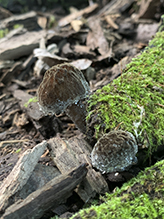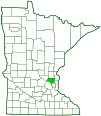Black Velvet Bolete
(Tylopilus alboater)
Conservation • Description • Habitat • Ecology • Distribution • Taxonomy
Conservation Status |
|
|||||||
| IUCN Red List | not listed |
|||||||
| NatureServe | NNR - Unranked |
|||||||
| Minnesota | not listed |
|||||||
Description |
||
Black Velvet Bolete is a dark, medium-sized mushroom. It occurs in eastern Asia and North America. In the United States it occurs from Massachusetts to Florida, west to Minnesota and eastern Texas, and in southern Ontario Canada. It is rare in Minnesota, where it is at the western extent of its range. It is found in summer and fall, alone, scattered, or in groups, in deciduous and mixed woodlands. It grows on the ground, usually under hardwood trees, especially oak. It has a mutually beneficial relationship (mycorrhizal) with the tiny rootlets of trees, absorbing sugars and amino acids while helping the tree absorb water. The cap is blackish-brown to dark grayish-brown or black. When it first appears it is convex, the upper surface is dry and is densely covered with short velvety hairs, and it is covered with a whitish to gray powder. As it matures it flattens out, becoming broadly convex. The mature cap is hairless and 1½″ to 3¾″ (4.0 to 9.5 mm) in diameter. When handled it bruises black. Older caps are finely cracked. The stalk is dry, hairless, 2″ to 2¾″ (5 to 7 cm) long, and ⅝″ to ¾″ (15 to 20 mm) thick. It is more or less equal in size but is sometimes enlarged at the base. It is the same color as the cap or a little lighter for most of its length, whitish and pinkish near the top. The surface is usually not covered with a network of fine ridges (reticulate) but is sometimes reticulate near the top. It bruises dark brown to black when handled. The pore surface is bright white when young, becoming pinkish as it ages. When bruised it usually stains first red then brown and eventually black, but sometimes goes directly to black. There are 2 pores per millimeter. The pore tubes are up to ⅜″ (10 mm) deep. The flesh is thick and white. When sliced it stains pinkish at first then slowly turns gray when exposed to air. It is edible when young, but like other boletes, mature specimens are often riddled with maggots. The spore print is pink. |
||
Similar Species |
||
Habitat and Hosts |
||
Deciduous and mixed woodlands |
||
Ecology |
||
Season |
||
Summer and fall |
||
Distribution |
||||
|
Sources |
|||
| 9/5/2022 | ||||
Occurrence |
||||
Rare in Minnesota |
||||
Taxonomy |
|||
| Kingdom | Fungi (Fungi) | ||
| Subkingdom | Dikarya | ||
| Phylum | Basidiomycota (Basidiomycete Fungi) | ||
| Subphylum | Agaricomycotina (Higher Basidiomycetes) | ||
| Class | Agaricomycetes (Mushrooms, Bracket Fungi, Puffballs, and Allies) | ||
| Subclass | Agaricomycetidae | ||
| Order | Boletales (boletes and allies) | ||
| Suborder | Boletineae | ||
Family |
Boletaceae (boletes) | ||
| Subfamily | Boletoideae | ||
Genus |
Tylopilus | ||
Synonyms |
|||
Boletus alboater Porphyrellus alboater Suillus alboater |
|||
Common Names |
|||
Black Velvet Bolete |
|||
Glossary
Mycorrhizal
A symbiotic, usually beneficial relationship between a fungus and the tiny rootlets of a plant, usually a tree.
Visitor Photos |
|||||
Share your photo of this fungus. |
|||||
| This button not working for you? Simply email us at info@MinnesotaSeasons.com. Attach one or more photos and, if you like, a caption. |
|||||
Honey Fae (Farah) |
|||||
… I’ve only ever found them once in August of 2020, just two growing out of a mossy tree trunk. |
|||||
 |
|||||
MinnesotaSeasons.com Photos |
|||||
|
|||||

Slideshows |
||

Visitor Videos |
|||
Share your video of this fungus. |
|||
| This button not working for you? Simply email us at info@MinnesotaSeasons.com. Attach a video, a YouTube link, or a cloud storage link. |
|||
Other Videos |
|||

Visitor Sightings |
|||||
Report a sighting of this fungus. |
|||||
| This button not working for you? Simply email us at info@MinnesotaSeasons.com. Be sure to include a location. |
|||||
| Honey Fae (Farah) August 2020 |
Location: Anoka County … I’ve only ever found them once in August of 2020, just two growing out of a mossy tree trunk. |
||||
MinnesotaSeasons.com Sightings |
|||||
|
|||||

Created: 9/5/2022
Last Updated:

